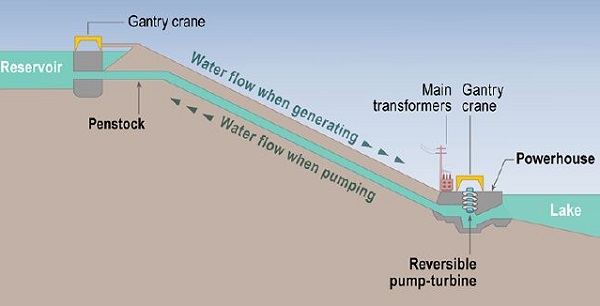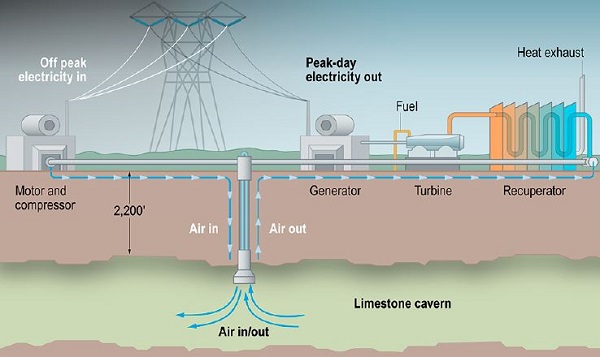I hope that readers have no doubts that we need to be headed toward decreased energy use, with more and more of that energy supplied by renewables, and less and less supplied by fossil fuels. This isn’t the “all of the above” strategy the Obama administration promotes; it’s an all-renewables policy, with the recognition that we won’t get there without a strong commitment or without a period of transition.
A key aspect of building that all-renewables future will be developing and deploying more energy storage technologies. Here there are a number of options. Some are deployed today; some appear to be ready for greater deployment; and some are on the cusp of practical application.

Let’s take a look at some of these. The biggest thing to remember with all of them is that ultimately the power they store (and then release) is only as clean as the resource used to create it.
Pumped Storage Hydropower
Pumped storage falls into the already in use category. In fact it accounts for 99 percent of all the grid-scale energy storage in the world today, at 127 gigawatts of capacity. This might sound encouraging, but in the U.S. — despite having the largest pumped storage project in the world (3 GW), in Virginia — less that 1 percent of all the power generating capacity of the nation can be stored with pumped storage.
So how does pumped storage work?
Basically, a pumped storage reservoir is built near a power plant (which could be fueled by anything), with another body of water either uphill or downhill. The power plant could be at the bottom of the hill or at the top. When the power plant generates more electricity than is needed at a given time, a pump system is used to pump water from the lower elevation to the reservoir at the higher elevation. When energy is needed, that water is released downhill, turning a turbine to generate electricity. About 70-85 percent of the energy used to pump the water uphill can be regained in letting it flow back downhill.

Pumped storage is one of the least expensive ways to store energy, but it’s still not cheap, it takes a long time to build and geographic requirements limit where projects can be built.
That’s too bad, because a recent assessment of different grid-scale energy storage solutions found that pumped storage was a definite winner in terms of its lifetime carbon footprint. Over a typical 30-year lifetime, a pumped storage project can store 210 times the energy needed to build the project and feed energy into it. Far, far better than any battery.
Compressed Air Energy Storage
Compressed air energy storage (CAES) can vary in the details, but all systems work by pumping air under high pressure into a storage area, such as a cavern or aquifer, and then releasing it to turn a turbine when power needs to be generated.

There are only two commercial compressed air storage projects operating in the world today, one in Alabama and one in Germany. Two more are expected to be completed in the next few years. All of which is somewhat surprising, considering that city-wide compressed air energy storage systems were built in the 1870s in Argentina, England, France and Germany.
CAES performs even better than pumped hydro in terms of lifetime carbon footprint, storing 240 times more energy than needed to build and fill the system.
Batteries
There are a number of materials suitable for grid-scale batteries, but few come close to either pumped storage or compressed air in terms of the number of times they can be used, or in their carbon footprint.
Recent research shows that lithium-ion batteries perform the best, with 6,000 charges, but still only store 10 times the amount of energy needed to make them. Sodium-sulfur batteries store six times their embodied energy, with vanadium redox batteries and zinc bromide batteries storing just three times as much energy. Lead acid batteries perform the worst, lasting 700 charges, and ultimately storing just twice the energy needed to create them.
Batteries certainly have their uses — where would portable electronics be without them? — but if they have a future for grid-scale energy storage their cycle life needs to be improved three to ten times, according to Charles Barnhart, who conducted the research at Stanford University that I’ve been drawing on for all these carbon footprint figures.
Molten Salt
Yes, molten salt. Molten salt falls into the category of thermal energy storage. A molten salt energy storage system words by heating a salt mixture of sodium nitrate, potassium nitrate and calcium nitrate, either in a solar power tower or parabolic trough — such as is used on concentrating solar power systems.
The salt melts at 131 degrees Celsius, is heated to about twice that temperature and then pumped into a collector, where it is heated by the sun to over 560 C. It’s then pumped into a storage container, where the heat is retained. When more power is needed — say either at night or when the sun isn’t sufficiently bright during the day — the hot salt is pumped into a conventional turbine system, where it is used to create steam to turn the turbine and create electricity.
Right now such systems are used some concentrating solar power plants in Spain — the photo at the top of this article is from one of these. In Nevada, a 110 MW solar power project with molten salt storage is expected to be completed and come online later this year.
One advantage of molten salt energy storage is that, unlike all the other options discussed here, it is by default a greener solution: the material is heated by the sun, so the issue of the storage method being only as clean as the original power source doesn’t apply.
Hydrogen
We’ve been hearing about the hydrogen economy for what seems like forever. There are a number of issues with using hydrogen as a power source, or power storage medium, beginning with the issue of it whether it is truly green. Yes, it emits only water vapor when consumed, but if fossil fuels are used to make the hydrogen, it loses its clean sheen.
If new research from the University of Calgary bears out commercially, however, all of that could change. Chemists there say they have developed a way that radically reduces the amount of electricity needed to create the hydrogen by electrolysis (splitting it out of water, H20), by using new catalysts based on inexpensive, Earth-abundant materials, including humble iron oxide.
The Calgary researchers believe that renewable sources could thus be used to power hydrogen production by electrolysis, taking advantage of the fact that the energy density of hydrogen is “a hundred times more than batteries or compressed air or the rest.”
Claims of new, less-expensive catalysts have been made before, however. So, until such a system is made commercially available — and that’s not assured — using hydrogen as an energy storage medium, made from renewable energy sources, remains out of reach.